The Autoblog 2020 Technology of the Year winner is Kia’s blind spot system. We judged the combination of blind spot monitoring and active blind spot crash avoidance on the 2020 Kia Telluride as the best in the industry.
The Kia blind spot system won with 204 points, beating the Mercedes E-Active Body Control (189), Subaru DriverFocus (182) and Ram Multifunction Tailgate (139). Autoblog’s editorial staff extensively tested the technologies last fall in Michigan. Three main questions were asked, and editors assigned point values out of 10 based on how well these technologies answered them. The questions were: What is its purpose? Does it work? Does it advance the industry?
Kia’s system starts with a traditional blind spot warning light in the side mirror. When equipped with the available head-up display, there’s a second warning light beamed onto the windshield in your line of sight adjacent to other information. This lets you know if there’s a car in your blind spot without even turning around to look. It isn’t a feature exclusive to the Telluride (Mazda does something similar), but Kia takes it a step further. The next level of warning is slightly more intense. If you activate the turn signal while the car senses something is in your blind spot, the steering wheel begins to gently vibrate. It’s not a violent or distracting buzz, but it’s enough to grab your attention. A warning chime is also activated at this time.
The cherry on top is something Kia calls the “Blind Spot View Monitor.” It uses a system of cameras to display a live camera feed of either the left or right blind spot in the central digital portion of the gauge cluster when the turn signal is activated. Hyundai uses a similar system in the Palisade and new Sonata. The monitor in the cluster allows you to see your blind spot from the ground up in the gauge cluster without having to turn your head. The view is dependent upon road conditions, but it’s a nicely integrated blind spot camera feed – the resolution is solid, and it’s still useful to a degree at night. We find Kia’s implementation to be superior to Hyundai’s, where the camera feed takes over the digital speedometer or tachometer when you flip on the turn signal. Kia sets the camera feed in the center screen where the trip computer normally displays.
This Blind Spot View Monitor tech is also a massive improvement over the comparable Honda LaneWatch technology. That system would obfuscate the infotainment display from you (annoying when sitting at traffic lights with your blinker on), and it was only capable of showing the passenger side view.
If all this fails, the blind spot collision avoidance system will attempt to prevent a crash for you. When an approaching vehicle is detected next to or too close behind your vehicle, the system can apply the brakes to the opposite side of the car, dragging it back over into your lane before a collision occurs. It notifies the driver in the dash when this activates.
All of this put together makes it much harder for a driver to initiate a crash with a vehicle in their blind spot.
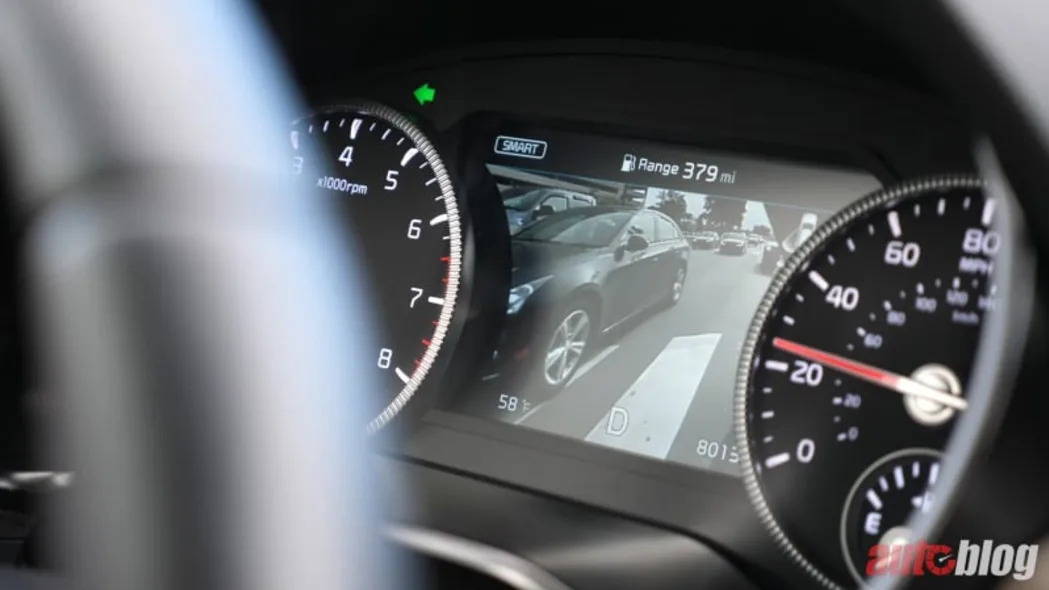
How does it work in practice?
We tested every aspect of Kia’s blind spot system, and yes, we even tested the collision avoidance system in real-world conditions. As with any blind spot warning system, the driver should still check their blind spots with a turn of the head at every lane change. But the brilliance of Kia’s system is the extra reassurance, ease of use, and reduction in stress – particularly on crowded city streets as bicyclists meander about everywhere. The system provides you with useful information before you turn your head, making the physical check of your blind spots less stressful – you don’t need to digest as much information in that split second as you would without the blind spot system.
It’s particularly useful in situations where we had to move several lanes on the highway. We were able to see the whole traffic situation three lanes over without having to turn an inch, allowing us to safely move one lane at a time with ease.
It was also helpful when a driver behind us tried to move into the same lane at the same time. This happens far too frequently and is extra difficult to spot as you’re making the lane change. With the camera feed in the dash, we can easily see the person a couple lanes over begin to edge into the lane. This allows us more time than usual avert a collision.
The Blind Spot Collision Avoidance (BCA) software also worked, but things aren’t as cut and dry with this one. It uses radar sensors to detect the presence of another vehicle beside or next to it, and the front-facing camera to keep tabs on the lane markings ahead. However, there are some limitations to the system that Kia details in the car’s owner’s manual. There are plenty of reasons for it not to work (inclement weather being one), but our sunny week of testing the Telluride didn’t bother it one bit. If anything, we wish the system was a bit more intrusive, something we don’t often find ourselves saying about driver assistance tech in cars.
We tried out the collision avoidance technology with a support vehicle near Autoblog headquarters on Woodward Avenue north of Detroit, a prime location for blind spot accidents to occur. The driver of the support vehicle (the guinea pig car in our blind spot) was to remain steady in his lane, so long as things didn’t become too hairy. It took some troubleshooting on distances and speeds, but we managed to get the system to activate in our somewhat unscientific tests. A message would flash in the central screen as the brakes on the opposite side of the car were pinched to gently pull us back to our original lane.
We had to get mighty close to our support vehicle for this system to kick in, but we were satisfied that it worked as promised by Kia. That said, we made a few observations worth noting. We noticed the system wasn’t keen to intervene when speeds were below 40 mph. The sweet spot for system recognition and action was when there were clear lane markings and speeds upwards of 50 mph.
The competition
Second Place: Mercedes E-Active Body Control
If our Technology of the Year award existed to recognize the wildest and sexiest technology implemented in a car, this would’ve won. As it stands, Mercedes’ E-Active Body Control came in a close second to Kia’s innovative suite of blind spot safety technology.
A conventional vehicle strut can only resist wheel motion, but E-ABC is a refinement of the company’s earlier ABC system, which uses high-pressure hydraulic fluid to push back against wheel motion by altering the struts damping characteristics actively. Each strut has its own cylinder, so the system can alter pressure to each one, limiting body roll and cancelling out choppy motions. It means ABC-equipped vehicles ride more smoothly and corner more flatly than any typical adjustable-suspension vehicle.
E-ABC builds on this earlier system by incorporating Airmatic air springs into the mix, so instead of only using the damper to provide or absorb forces, the system can also alter the spring rate. It can increase or decrease the spring rate to add more overall capability to the system – in other words, a greater degree of body control and ride compliance.
What you end up with is a massive SUV that doesn’t squat or pitch. It even has a “Curve Mode” that actively leans into corners as you turn the wheel. In practice, you get an uncanny but enjoyable boat-like motion, like a high-performance ski boat making a sharp turn on clear water. The system really shines off-road, allowing the driver to raise or lower any one corner of the car independently via the touchscreen display, potentially aiding an escape from rough terrain. Then there’s the infamous Free Driving Assist mode, which rocks the vehicle (in our case, a Mercedes-Benz GLS 580) up and down for 30 seconds. It’s hilarious to watch and be a part of, so long as your stomach can handle it. The point is to escape from deep sand or snow by alternately increasing and decreasing the ground pressure from the tires. People will point. They will almost certainly reach for their phones. It’s all good fun – but moreover, it works.
Other more useful advantages to the tech include Mercedes’ “Road Surface Scan” and its ability to recuperate energy from rough roads. The road monitoring system is able to scan the road ahead and prepare the shocks to smooth out surface undulations before you even reach them — this existed previously, but it’s even better now. We were impressed by the ride on rough dirt roads, as the GLS was much friendlier to us than an SUV of its size typically is on such terrain. Its ability to recuperate energy from poor road surfaces also lessens the electric load of running the system. We’ll be especially grateful for that tech once it’s implemented on EVs.


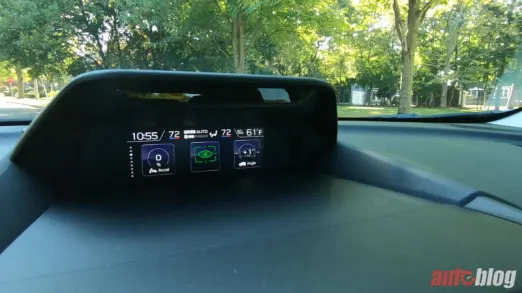
Third Place: Subaru DriverFocus
Subaru’s DriverFocus system debuted on the redesigned Subaru Forester. Its combination of safety and convenience features made it a candidate for our Technology of the Year award. The system uses an infrared camera above the central screen to monitor the angle of the driver’s face for inattentiveness and their eyes for drowsiness. It’s tied in with facial recognition software that reaps even further benefits.
From a safety perspective, DriverFocus is able to tell if you're facing the road ahead, then scold you for being distracted. If you look down or away from the road in any direction, the car will sound a warning chime and display a message telling you to keep your eyes on the road. However, it’s not foolproof. The camera is decent at picking up head movements, but not so great at reading your eyes. We found that if we could keep our head in the same forward-facing position, the system wouldn’t mind our eyes straying. For example, we were able to look down at a phone without shifting our head position, and the system raised no alarms. However, if we turned our heads and kept our eyes on the road, warning chimes would go off left and right. For this tech to be fully-baked, the system needs to constantly track our eyes, and not just monitor for drowsiness.
The convenience features that come with DriverFocus are splendid, though. If your face is programmed into the system (an arduous task on the Forester but much easier on the new Outback and Legacy), it’s able to remember your seat position, mirror position, climate control settings and infotainment screen arrangement. The Forester is capable of storing up to five faces, so your family of drivers can be large. Of course, much of this can also be accomplished via memory seats or programmable key fobs. Subaru accomplishes the same task by recognizing the driver via points on their face and then adjusting the settings accordingly. It’ll recognize you in the dark and through sunglasses — we tried to fool it using various methods of trickery but had no luck. Good work there, Subaru. For those worried about your face data being stored, Subaru says that it only remembers points on a face and doesn’t recognize a specific person.
Ultimately, this tech is good – we think it’s the beginning of a bright future in facial recognition in cars – but it’s not yet perfect in practice. It’s also only available on the top-tier, expensive Limited trim on the Forester.


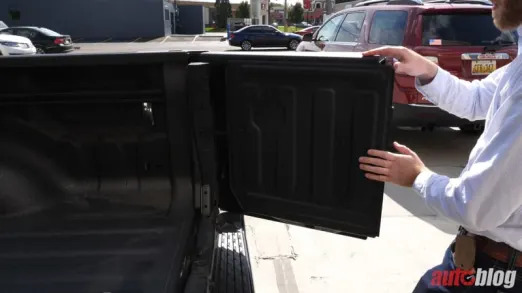
Fourth Place: Ram Multi-Function Tailgate
Bringing up the rear (by a fairly decent margin) is the Ram Multi-Function tailgate. It’s the latest punch thrown in the tailgate fight following the GMC Multi-Pro tailgate. We invited this trick tailgate along to see if it fared any better than the GMC did in last year’s Technology of the Year testing.
Ram’s tailgate is the simplest of all the technologies on display here. Pull up on the latch to open the tailgate the traditional way, or press down to swing one part out to the side. One more latch is hiding on the portion of the tailgate still attached to the truck, and then that swings out to be about parallel with the truck’s body. At this point, one can easily walk right up to the bed for easier loading/unloading of the bed’s contents. It’s a 60/40 split; that means you end up with a strange looking body line on the right side of the tailgate, but a black truck hides it well.
The tailgate only managed to offend a couple editors who found it generally unnecessary and unintuitive, but most of us were just milquetoast on it. We like it more than the unwieldy and overly complicated GMC Multi-Pro tailgate, but not enough for it to score better than the advanced safety and suspension technologies on display in this test. It’s something that certain users may find beneficial to their truck experience, but an essential component of the Tech of the Year Award is that the item needs to be a game-changer with the potential to become widely adopted. The tailgate is convenient, but it doesn’t radically alter the user experience.
Related Video:
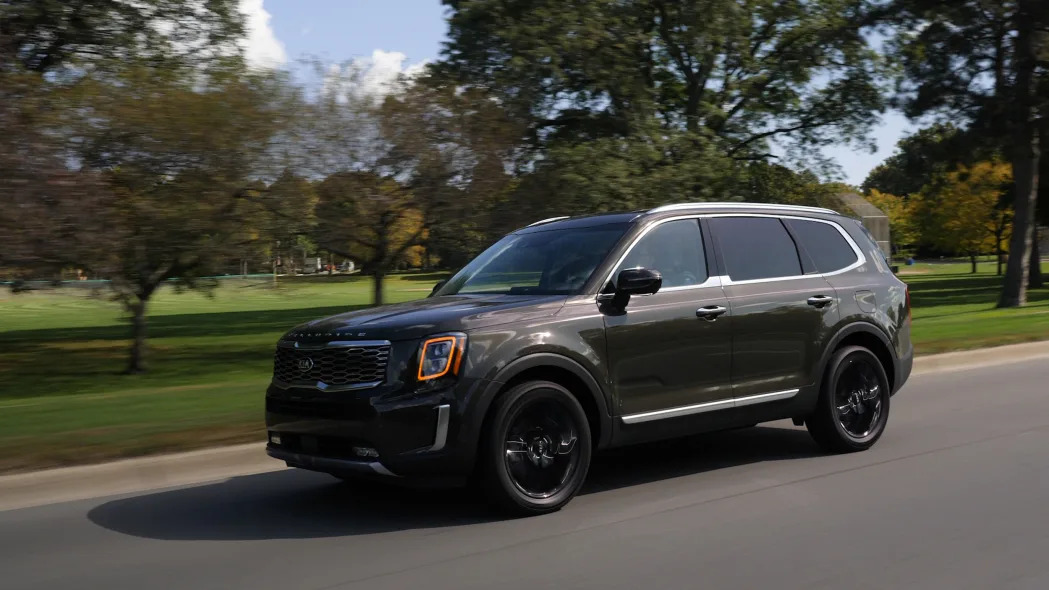

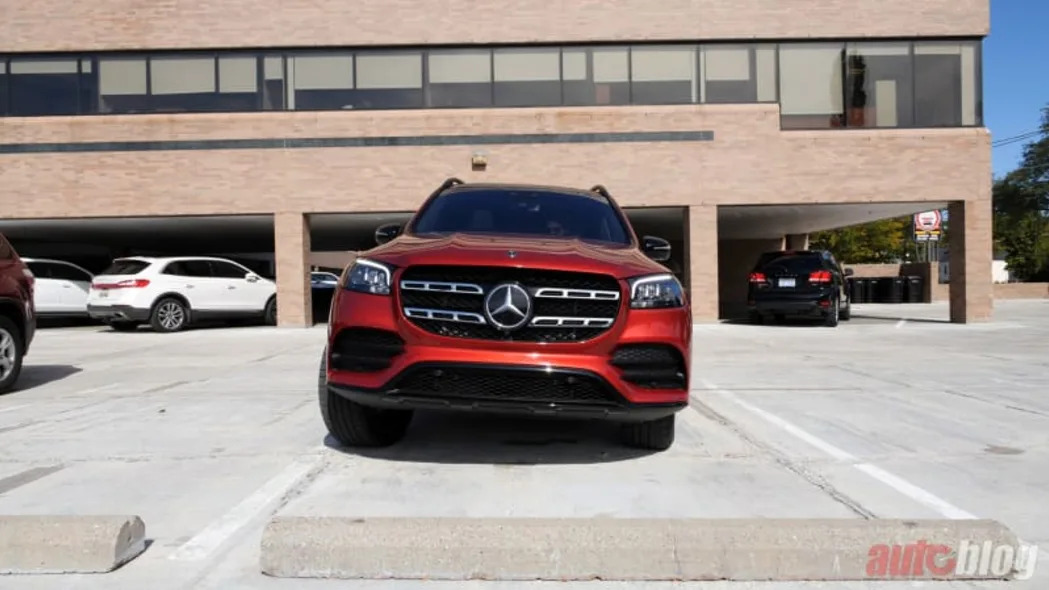

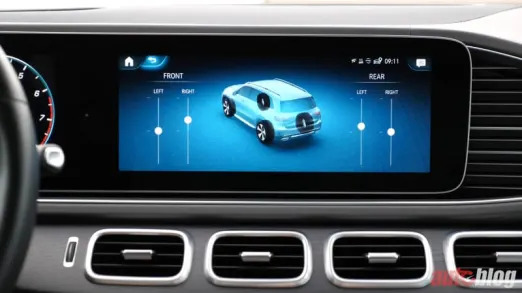

Sign in to post
Please sign in to leave a comment.
Continue